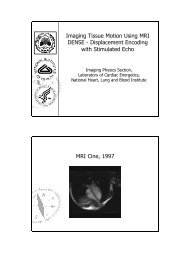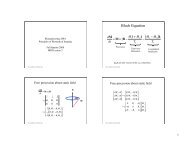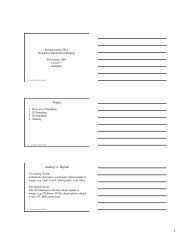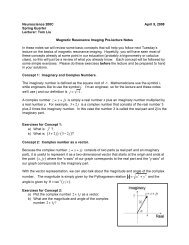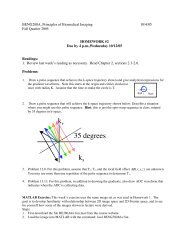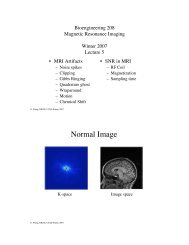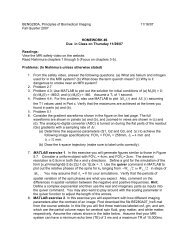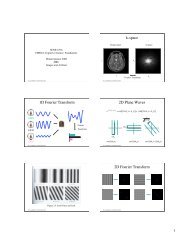Lab 9 - Center for Functional MRI
Lab 9 - Center for Functional MRI
Lab 9 - Center for Functional MRI
You also want an ePaper? Increase the reach of your titles
YUMPU automatically turns print PDFs into web optimized ePapers that Google loves.
2. Combined ASL and BOLD f<strong>MRI</strong>. In this exercise, you will collect dual echo ASL data<br />
during the per<strong>for</strong>mance of a functional task. Using the parameters from Scans 3 and 4<br />
above, collect 2 functional scans with task timing 30s off - 4x(30s on, 30s off). Finger<br />
tapping will work well. For both scans, set the following 2 CVs:<br />
- opnecho->2 to prescribe a dual echo acquisition. This collects one minimum TE<br />
scan, followed immediately by a second scan at longer TE.<br />
- opte2->30ms – this sets the second echo time to 30ms<br />
When you reconstruct this data, you will end up with 4 time series: one <strong>for</strong> each echo of<br />
each scan. To get a quick look at the data, you can look at it in afni to see the BOLD<br />
signal. Which echo should you be looking at Recollect data if you don’t see a clear<br />
activation. For each of the 4 image time series, go through the following processing<br />
steps:<br />
a. Within afni, run the plugin a3/d3 to generate separate ASL and BOLD time series.<br />
This plugin subtracts from each image the average of the previous and the next image,<br />
creating a new time series of signal differences (the ASL signal), and it also adds to each<br />
image the average of the previous and the next image, creating a new time series with<br />
the ASL alternation removed (this can be used as a BOLD timecourse). You now have<br />
8 time series (4 ASL and 4 BOLD).<br />
b. From the short TE ASL data set (whichever TI looks better), look <strong>for</strong> functional<br />
activation and generate a mask <strong>for</strong> the activated ROI. Use the same mask <strong>for</strong> all data<br />
sets.<br />
c. From each of your 8 timecourses, calculate the absolute and fractional signal increase<br />
with activation within the ROI. (3 points)<br />
Questions (1 point each):<br />
1. Which ASL data set gives the largest absolute activation Why<br />
2. Which ASL data set give the largest fractional activation Why<br />
3. Which ASL data set is most likely to reflect the true fractional CBF increase Why<br />
4. Should the first or second echo be used <strong>for</strong> the ASL measurement Why<br />
5. Which BOLD data set gives the largest absolute activation Why<br />
6. Which BOLD data set gives the largest fractional activation Why<br />
7. Should the first or second echo be used <strong>for</strong> the BOLD measurement Why



